How To Change Oil Filter On Oil Furnace
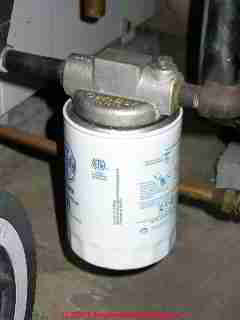 How to Change the Oil Filter Cartridge on an Oil Burner
How to Change the Oil Filter Cartridge on an Oil Burner
& How to choose the right oil filter cartridge size
- Post a QUESTION or COMMENT about installing, servicing, and repairing oil filters used on oil-fired heating equipment & water heaters
InspectAPedia tolerates no conflicts of interest. We accept no relationship with advertisers, products, or services discussed at this website.
Heating oil filter change:
Step past Step Oil Filter Modify Process. This article series describes the installation, use, maintenance, and repair of oil filters used on oil-fired boilers, furnaces, and water heaters.
Nosotros discuss tracking down air and oil leaks at or nigh the oil filter canister and we depict proper oil filter location and issues to bank check for during oil filter cartridge changes.
We also provide an ARTICLE Alphabetize for this topic, or y'all can try the page height or bottom SEARCH BOX as a quick style to observe information you need.
How to Change a Heating Oil Filter: Step by Step Procedure for Servicing the Oil Burner Oil Filter Cartridge
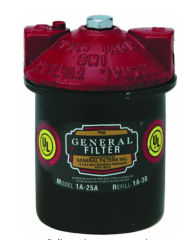 The oil filter cartridge should be changed during oil heating equipment annual cleaning, service, and tune-up.
The oil filter cartridge should be changed during oil heating equipment annual cleaning, service, and tune-up.
You should not accept to change oil filter cartridges more often. If the cartridge clogs and leads to service calls or heat loss between annual service calls then we doubtable the oil tank is contaminated with water or sludge - problems that need to be corrected at the oil tank.
Analogy: the General 1A-25B heating oil filter canister, used on many domestic oil burners. This canister or "container" receives the General 1A-30 oil filter cartridge or an equivalent.
[Click to enlarge whatever image]
The procedure for changing the oil filter cartridge is simple, but if it's performed improperly y'all could be left with no rut.
- Turn off electrical power to the heating appliance (boiler, furnace, h2o heater) whose oil filter is to be serviced
- Place a catch pan or basin beneath the canister to grab any oil spills or drips
- Turn off oil supply to the organisation by closing the burn prophylactic valve that should be located between the oil filter and the oil feeder supply line from the oil tank.
If the valve is a fire-safety-valve information technology includes a jump-loaded fusible link that closes the valve in case of fire.
These valves piece of work in the opposite direction from conventional plumbing valves. Screwing the valve top out or counter-clockwise closes the valve.
- Remove the oil filter canister base of operations:
For oil canisters with a middle bolt such as the unit shown simply above, loosen the bolt institute in the center of the canister top and remove it.
Take care non to lose the fiber washer that seals the canister bolt and take intendance not to lose or damage the O-ring that seals the canister base to the canister lid.
Watch out: for oil filter canisters that are supported simply by oil pipage yous'll be wise to support the canister lid or assembly whenever loosening parts.
Otherwise you may twist, bend, and cause leaks in the oil supply piping. Use 2 wrenches to loosen or tighten the canister bolt: one on the bolt itself and 1 on the rectangular projection at the canister hat inlet or outlet side. Leaks here cause oil burner startup bang, puffbacks, loss of heat. Details are
at OIL LINE Pipage LEAKS.
Watch out: the canister bottom may simply fall off at this point - yous will want to take hold of it to avoid unnecessary oil spillage. Other oil filter canisters may lack the commodities and may take to be opened by united nations-screwing the canister base from the height.
- Remove dingy oil filter cartridge and place it in a plastic purse for suitable disposal along with any waste oil and sludge collected during this process.
- Clean the oil filter canister: remove any oil sludge, dirt, debris from the bottom of the oil filter canister base of operations.
Bank check for water contagion in the oil tank when irresolute the oil filter cartridge.
H2o contamination in oil tanks tin can be detected by examining the lesser of the oil filter canister.
If you lot see bodily h2o, or more likely rusty ruby sludge, that may be good show that water from the oil storage tank has been trapped in and rested in the bottom of the oil filter canister.
For details
see OIL TANK WATER CONTAMINATION
- Insert the new oil filter cartridge into the canister base.
If your oil filter replacement package included a new O-ring for the canister base-to-lid seal, use it to replace the old O-band that nosotros told you to relieve in step 4.
Our photograph (left) shows a typical heating oil canister filter and the gaskets that are packaged with it.
The General 1A-xxx replacement oil filter cartridge shown at the left of our photo is in about canisters inserted with the screen upward where it fits into a recess in the canister lid.
This filter cartridge fits the General 1A-25B oil filter canister as well as some other manufacturer's brands of an equivalent size.
That large round gasket is used to seal betwixt the oil filter canister pinnacle and the base.
Inside the big gasket we prove two smaller ones. The smallest crimson gasket is used under the air drain spiral institute on the top of the oil canister, and the larger red gasket is used nether the mounting bolt that secures the oil filter canister base of operations to its top.
- Heating oil filter canister reassembly:
Carefully, keeping the filter cartridge centered in the canister base, place the canister base of operations up nether the canister lid in proper position.
- Replace the heating oil filter canister mounting bolt
(and a new fiber washer if ane was provided in your oil filter cartridge kit) to secure the canister base to the lid, tightening the bolt deeply just not so tight as to damage threads. If your canister does not utilise a center bolt the base of operations unremarkably assembles by screwing in in identify into the lid.
Watch out: equally we warned above, for oil filter canisters that are supported only past oil piping yous'll be wise to support the canister lid or assembly whenever tightening parts. Otherwise y'all may twist, bend, and cause leaks in the oil supply piping. Details are
at OIL LINE LEAKS - Oil Line leaks found.
- Open up the oil supply valve to permit oil to enter the oil filter canister and then
- Drain air from the oil filter canister using the procedure we detail just below
at OIL FILTER AIR BLEED STEPS. Utilize a new fiber washer for the air bleeder screw if one was provided in your heating oil filter kit. Call back to close the bleed screw at the stop of this procedure.
- Plow on electric power to the heating appliance and
- Permit the oil burner to run to assure that the system starts and runs properly.
- Leak check: Bank check the oil piping and the oil filter canister top, center bolt and air bleeder commodities and any nearby fittings for evidence of oil leaks.
Details of just where leaks occur at or around heating oil filters are
at OIL LINE Pipe LEAKS
andat OIL FILTER LEAK POINTS.
- Dispose of heating oil: if you lot collected heating oil in your drip pan and see that the oil is clean y'all can simply pour it into your oil tank through the filler pipe. Don't pour sludge, dirt, debris into the tank however.

Drain Air from the Heating Oil Filter Canister after an Oil Filter Cartridge Change
 In one case you have installed the new oil filter cartridge inside the canister you volition demand to bleed air out of the canister and filter earlier restoring the system to service.
In one case you have installed the new oil filter cartridge inside the canister you volition demand to bleed air out of the canister and filter earlier restoring the system to service.
If your heating oil tank is at a level higher than that of the filter itself this is an easy task as oil may flow from the tank through the filter without fifty-fifty having to run the oil burner.
But nearly heating service techs simply turn up the rut to cause the oil burner to turn on, bypassing the cad cell relay if necessary to keep the burner running even before actual flame ignition.
Spotter out: exercise not endeavour this burner-on method if you don't take the necessary training: pouring a dose of un-burned oil into the combustion chamber is dangerous and risks a puffback.
With your catch-bowl below the oil filter canister, simply loosen or remove the air bleeder screw located on the canister elevation but before the canister outlet fitting (ruddy arrow in our photo at left, courtesy of reader E.Due south.).
Then open the oil supply valve to permit oil to flow from the oil tank into the canister. You may hear or feel air escaping at the air bleeder opening.
Once you see a clear flow of heating oil at the bleeder opening you lot can supervene upon the screw that closes that port.
Watch out: don't forget to include the fiber washer that seals the screw to the canister head or you may take oil or air leaks at the canister.
Tips for the Follow-Upwards Check for Oil Leaks After Oil Filter Cartridge Change
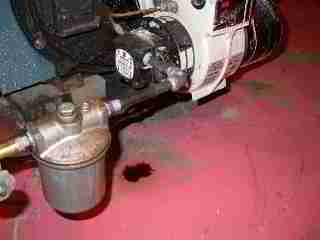 Afterward any service procedure that disturbs oil line, filter, or burner oil piping fittings we recommend checking for evidence of oil leaks once again afterwards the organisation has been in use for a day or so, because dull leaks and small leaks in the oil pipe system may not testify up immediately.
Afterward any service procedure that disturbs oil line, filter, or burner oil piping fittings we recommend checking for evidence of oil leaks once again afterwards the organisation has been in use for a day or so, because dull leaks and small leaks in the oil pipe system may not testify up immediately.
Clean the flooring beneath and around the heating oil filter and oil piping. Cheque dorsum in a twenty-four hour period or two for fresh heating oil spots on the floor (beneath left).
If you leave a clean newspaper towel beneath the oil filter and connectors it can make spotting an oil drip easier.
Fix any oil leaks immediately. An air leak into the oil piping organisation leads to improper oil burner operation, risking a dangerous puff-back, or loss of oestrus in the edifice.
Reader Question: spin-on / off heating oil filter maintenance
10/xxx/2014 Anonymous said:
The furnace oil filter changing instructions are for canister and not the spin-on cartridge pictured.
Are there separate instructions for removing and replacing a spin-on fuel filter cartridge (Gar-ber, Granby, etc)?
Reply:
Cheers Anon for pointing out the need for this clarification. For a spin-on type oil filter cartridge the basic steps are the same: shut off the equipment, shut off the oil supply, place a pan to grab drips, remove and replace the filter. The primal difference is that there is no center bolt to remove to drop the filter (as is the case with General Filters).
The mounting hardware for this filter is (as with other brands) specific to the filter brand, size, type. Gar-Ber filters,for example, include a die-cast metal head to which the oil lines are connected and to the under-side of which the Gar-Ber spin on heating oil filter screws on and off. The Gar-Ber filter caput includes a port for a vacuum approximate and it also includes an air bleeder screw that serves the same function as nosotros describe in the article above.
Gar-Ber spin-on / off oil filters are distributed past General Filters - generalfilters.com
Granby spin-on / off oil filters (Granby EX200-999) are distributed by Granby Industries - granbyindustries.com and also provide mounting hardware that connects to heating oil lines and that besides includes an air bleeder plug. Granby likewise sells a traditional middle-bolt oil filter likewise. Granby notes that their 10 micron spin-on oil filter works with all spin-on filter heads of the aforementioned type and fit the CGF-10, Kerr K10, Purolator Per-103 and Nozzle Baby-sit NG1500-M oil filter mounts.
Granby's instructions include this helpful note that gives some heating oil line vacuum reference points
"SERVICE: Replace the filter chemical element at the beginning of each heating season, or when running vacuum exceeds vi'' Hg on one-pipage systems or 15''Hg on two-pipage systems."
Reader Comments & Q&A
@Gene,
Yous may have been confused by people mixing names for the oil filter canister - the metal container that holds the actual heating oil filter and the actual oil filter cartridge that is inserted into the canister and through which the heating oil is filtered.
In your question " I've seen the cartridges in sizes 1A25B and 1A-30. " actually the 1A25B is the proper name for the oil filter canister (container) manufactured by General, ,and the 1A-xxx is the oil filter itself that is inserted into that canister.
For residential oil burners most use an oil filter canister (the can that holds the filter) such as the General Filter Model 1A-25A.
That filter uses cartridge refills in size 1A-30.
There are likewise substitute oil filters that will fit in that canister similar the F15-48 that are perfectly compatible
Also compatible is the A-315 filter. What's different is the material only the size and performance of all 3 fit into the 1A-25A canister.
Some residential oil burners and some commercial burners use a larger capacity oil filter canister such as the General Model 2A-700B.
This larger canister uses as actual filter cartridge refills the 2A-710BG, or the 2A-710, 101, or RF2 oil filter cartridges.
I'll add illustrations of these oil filter canisters and filter cartridges to analyze their use.
Thanks for asking.
 ...
... 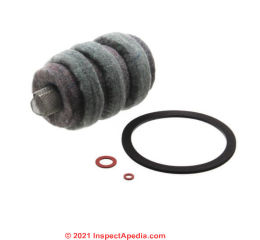 ...
...
Higher up: The General 1A-25A oil filter canister and its standard filter cartridge, the 1A-30. This is the nearly-mutual residential oil burner filter size, though equivalents are available from other manufacturers.
Below: the F15-48 oil filter cartridge from Westwood, and the rather different-looking merely same size Fulflo F10-209 oil filter cartridge, both of which fit and work in the General 1A-25A oil filter canister shown higher up.
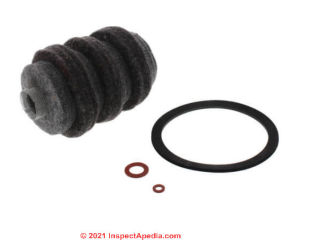 ...
... 
Below: the larger General 2A-700B oil filter canister, and the General 2A-710 oil filter cartridge that fits into this larger canister.
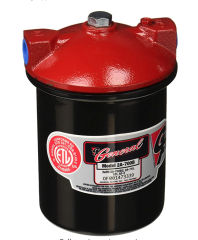 ...
... 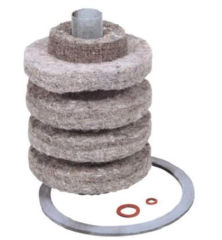
Other heating oil filter brands
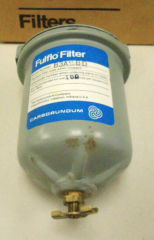 ...
... 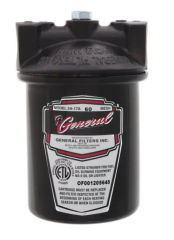
Above: the Parker Carborundum Fulflo procedure liquid filter model B3A-1/iv" BD (Bottom drain), and next to information technology,
the General Aire from General Filters, Model 2A-17A similar to the General fifty 2A-700B in a higher place. The 2A-17A oil filter tin be used with No. 2, four, 5, an No. six fuiel oil. It is also used for othe roil filtering applications.
Beneath: the Westood heating F65 oil filter canister, as well using a cast-iron meridian and the company's Pure-Oil filter element - filter cartridge Nos. F30-24, F35-12, F35-24.

Meet this
- General FUEL OIL FILTER CATALOG [PDF] (2015) General Filters, Inc. 43800 Thou River Avenue, Novi, Michigan 48375 United states of america, Tel: (866) 476-5101 Email: customerservice@generalfilters.cofor a more-exhaustive list of models and features of various heating oil and fuel oil filter products.
Canadian contact: Canadian General Filters, Ltd. 400 Midwest Rd. Toronto, ON M1P3A9 (888) 216-9184 sales@cgfproducts.com
- WESTWOOD OIL FILTER CATALOG [PDF] (2013) Westwood Co., Tel: ane-800-442-1630
How do you know which size oil filter cartridge to utilise? Mine is the canister type with the felt insert but I've seen the cartridges in sizes 1A25B and 1A-30. There doesn't seem to be a size identified on the canister.
Thanks!
Thanks, Matt, for a helpful question.
These fire safety valves work "backwards" from typical plumbing shutoff valves.
Turning the circular handle COUNTER-CLOCKWISE (to the left) OPENS the valve. When you lot plow the handle to the left or counter-clockwise you'll see the valve stem rise up through the round handle.
The reason the valve works this way is that in the open position the valve stem has compressed a jump that, combined with a fusible link, will push the valve face up "downward" to "close" the valve in the issue of a fire.
Turning the fire-safety-valve handle CLOCKWISE (to the right) will Close the valve.
Doing this, yous'll run across the round spiral stem movement down in the valve, as the valve gate is closing.
Thanks for the word.
Yous said "If the valve is a fire-condom-valve information technology includes a bound-loaded fusible link that closes the valve in case of burn down.
These valves work in the opposite direction from conventional plumbing valves. Screwing the valve acme out or counter-clockwise closes the valve"
I believe information technology's the opposite, turning it counter clockwise opens the valve. Information technology lifts the stem upwards, clockwise seats it, closing the valve.
Deut
I'd need to see a photo to understand the exact situation, merely mostly if there is a vacuum gauge between the oil filter and the fuel unit (oil pump) it will show several inches of vacuum when the unit of measurement is running.
The service tech uses vacuum measurement to see if at that place are air leaks in the oil line or a bad fuel unit or similar problems.
A gauge on the high pressure line will read 100 psi or higher depending on how the fuel unit has been adapted.
Watch out: pressure gauges in any location on a heating oil line or high pressure line betwixt pump and burner should not be left permanently in identify unless there are fittings to close off oil pressure level in to the gauge - to isolate it from the piping; my concern is that a outburst gauge could spew oil all over and start a building fire or a leak at a gauge on the suction side of the pump may leak air into the system causing unsafe burner operation.
PLEASE read the details at OIL LINE VACUUM & Pressure TESTS
and then don't hesitate to ask further questions.
What should the estimate after the oil filter read when everything is running correctly?
My gauge is at half-dozen or seven should the filter be replace? Ty Joe d
Admittedly, Naz, air needs to be removed from the organisation for safe and proper oil burner performance.
Hello - i have no issue with my furnace other than an oil stench, it is an old arrangement (thirty years +)
I am going to replace the oil filter, but the bleed is at the burner since it is a
Carborudum FB4 filter housing. Practise I need to bleed the organization afterward replacing the filter or can I skip this step?
Cheers
Denise
I holding the upper body of the oil filter with a suitable wrench and using an oil filter canister wrench on the bottom you should be able to unscrew the filter from the present installation. If not you could replace the entire assembly with a new oil filter assembly such equally that made past General.
 This is on so tight that I tin can't get it off. Do they make these kinds of filters
This is on so tight that I tin can't get it off. Do they make these kinds of filters
whatsoever more than . How can I get it off?
Original IMAGE LOST by older version of Clark Van Oyen's useful Comments code - now fixed. Please re-mail the image if y'all can. Sorry. Mod.
Kevin
I supersede the filter at almanac oil burner service. If y'all find that the filter is clogging and having to be replaced more-ofttimes than that there's a problem to be found and stock-still at the oil tank - at the very to the lowest degree by increasing the filter chapters and so as to make information technology to annual service.
Awesome info- thanks so much! How oftentimes should I replace the cartridge in my filter? Is this like a once-a-twelvemonth kind of thing? Thanks in advance.
What if my oil filter housing does Not take a bleeder screw but is one of the ones securing a filter with a bolt attainable from the top? Is there some other bleeding method?
Likewise, the housing is pretty rusted on mine. Should I but replace the whole housing with a newer one?
Mike:
Use the page height or lesser CONTACT link to transport me precipitous photos of the oil filter housing and any labeling on it and I'll enquiry and reply.
Daniel
My oil tank has a 'Commercial' brand filter housing with a apartment-head screw centered into its plastic housing in place of a bolt. Can you lot offer a scrap of guidance on how to modify the cartridge?
Thanks
Give thanks you for your valuable instructions and likewise for your forrad thinking warnings.
Cheers,
David
...
Continue reading at OIL FILTER LEAK POINTS or select a topic from the closely-related articles below, or encounter the complete Commodity Alphabetize.
Or run into
Heating Oil Filter Articles
- OIL FILTERS on HEATING EQUIPMENT
- OIL FILTER Change STEPS
- OIL FILTER LEAK POINTS
- OIL FILTER MISSING
- OIL LINE Pipage LEAKS
Suggested citation for this web page
OIL FILTER CHANGE STEPS at AuditApedia.com - online encyclopedia of building & environmental inspection, testing, diagnosis, repair, & problem prevention advice.
Or come across this
Index to RELATED Articles: ARTICLE INDEX to HEATING OIL, OIL BURNERS, OIL FIRED HEATERS, OIL TANKS
Or use the SEARCH BOX found below to Ask a Question or Search InspectApedia
...
Ask a Question or Search InspectApedia
Try the search box just below, or if you adopt, post a question or comment in the Comments box below and nosotros volition reply promptly.
Search the InspectApedia website
Note: appearance of your Comment beneath may be delayed: if your comment contains an image, web link, or text that looks to the software equally if it might be a spider web link, your posting will appear afterwards information technology has been approved by a moderator. Apologies for the delay.
You will non receive a notification when a response to your question has been posted.
Please bookmark this page to brand it piece of cake for y'all to check dorsum for our response.
Our Comment Box is provided by Countable Web Productions countable.ca
Technical Reviewers & References
Click to Show or Hibernate Citations & References
Source: https://inspectapedia.com/oiltanks/Heating_Oil_Filter_Change.php

0 Response to "How To Change Oil Filter On Oil Furnace"
Post a Comment